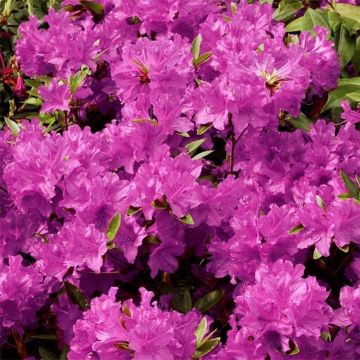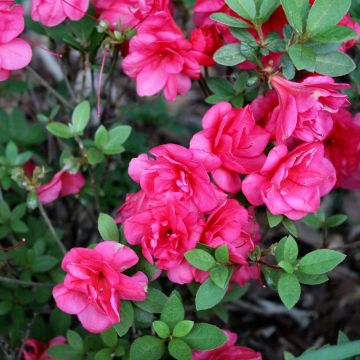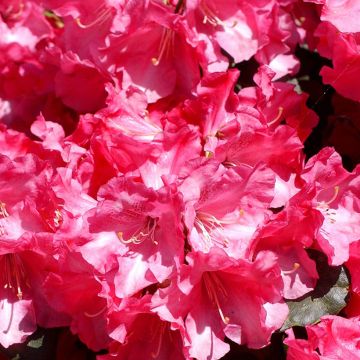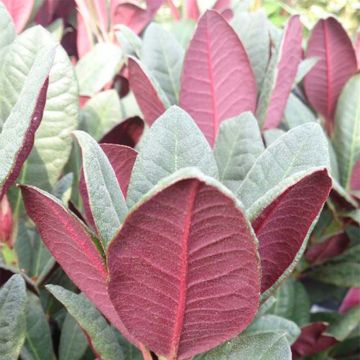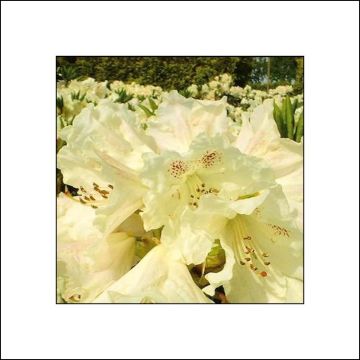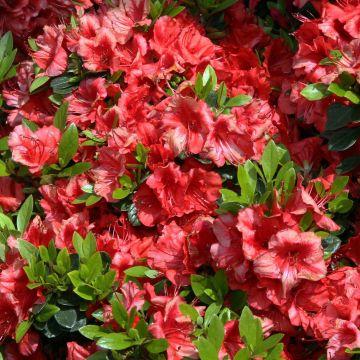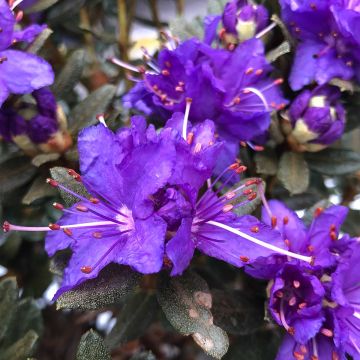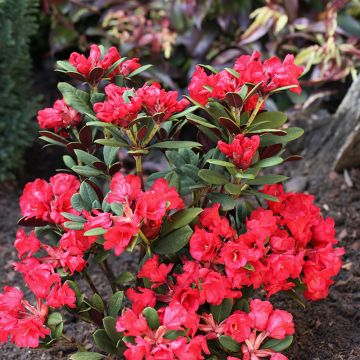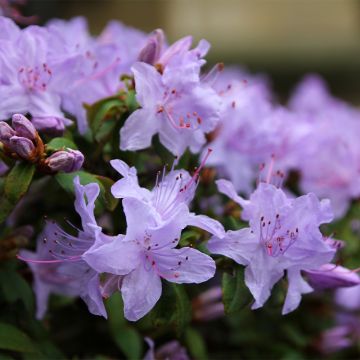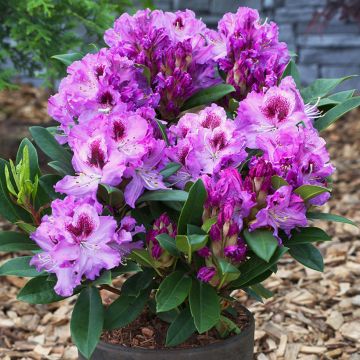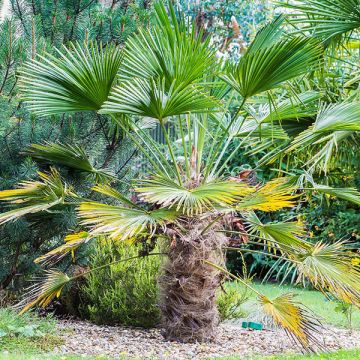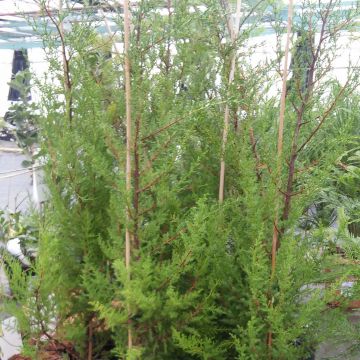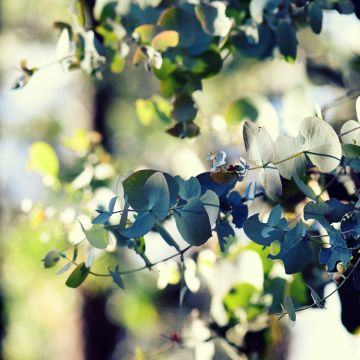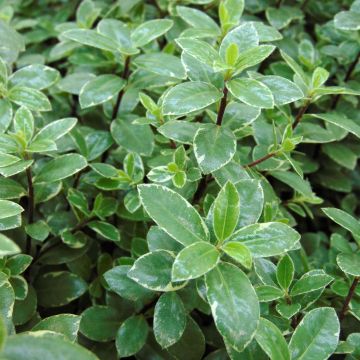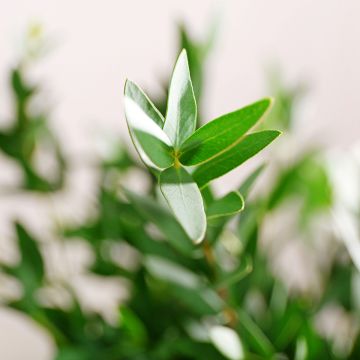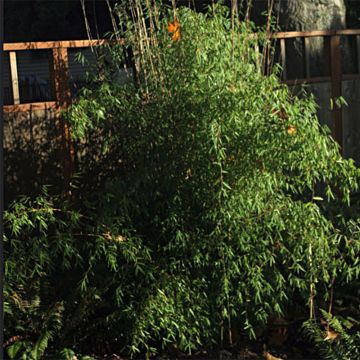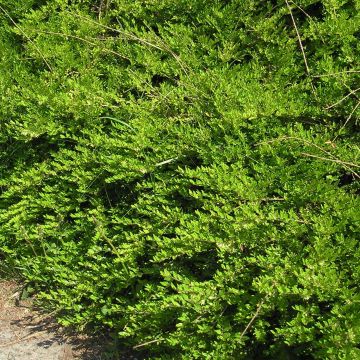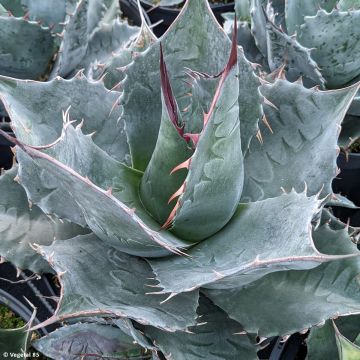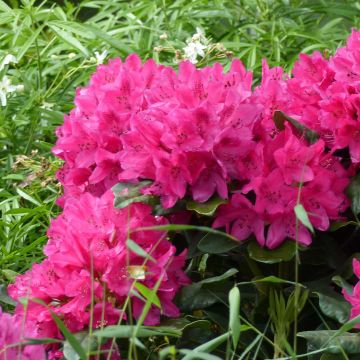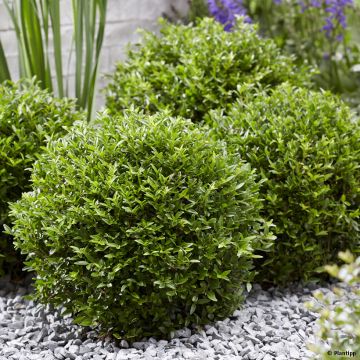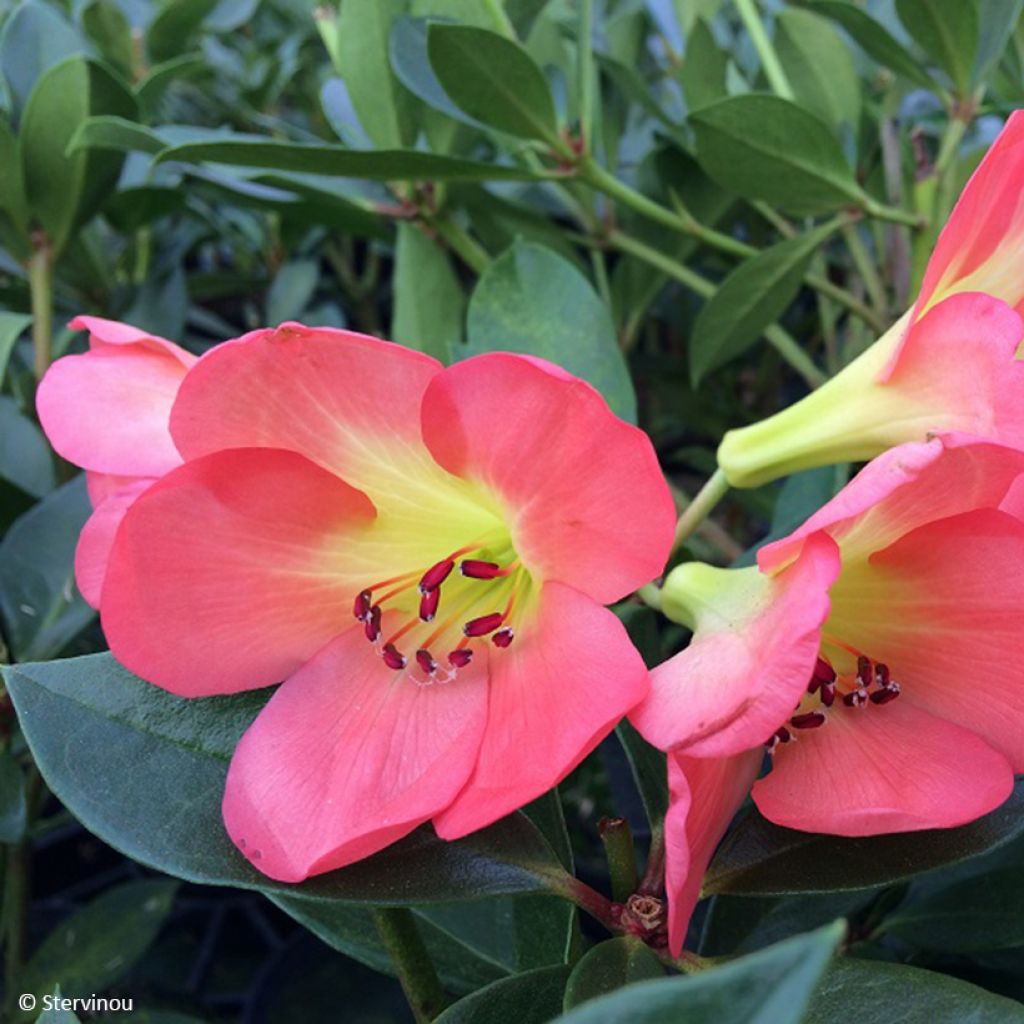

Rhododendron vireya Oogappel - Tropical Rhododendron
Rhododendron vireya Oogappel - Tropical Rhododendron
Rhododendron Oogappel
Tropical Rhododendron
This item cannot be shipped to the selected country
Delivery charge from €5.90
More information
Schedule delivery date,
and select date in basket
This plant carries a 24 months recovery warranty
More information
We guarantee the quality of our plants for a full growing cycle, and will replace at our expense any plant that fails to recover under normal climatic and planting conditions.
From €5.90 for pickup delivery and €6.90 for home delivery
Express home delivery from €8.90.
Does this plant fit my garden?
Set up your Plantfit profile →
Description
Rhododendron 'Oogappel' is a rare tropical plant that forms an evergreen bush with beautiful dark green glossy foliage. It offers an extremely ornamental long-lasting winter flowering. Its trumpet-shaped flowers are salmon pink with a yellow throat, creating a stunning contrast against the dark foliage. Being tolerant to only light frosts, this variety should be grown in a container, in acidic soil, in a partially shaded location and brought indoors to protect it from frost in winter.
The Rhododendron is an important member of the Ericaceae family, which consists of numerous ornamental genera such as Japanese Andromeda (Pieris), Heathers, and the charming Gaultheria. There are approximately 850 species of Rhododendron, which has led to a complex botanical classification divided into subgenus, section, and subsection.The Vireya section (named after a French pharmacist, Julien-Joseph Virey, 1775-1846) includes no less than 300 tropical species, often epiphytic (growing on trees, like many orchids in warm countries), while others are terrestrial and grow in the ground, like the hardy Rhododendrons commonly found in our gardens.
'Oogappel' is a variety from this exotic section, whose name literally means "eyeball" in Dutch but is actually used to refer to a loved one, the apple of one's eye. It forms a semi-epiphytic bush, larger than other varieties of Vireya. Slow to moderate-growing, reaching 50 cm in height and width after 5 years of cultivation, it will mature to a height of 1.50 m with a similar spread. It is adorned with evergreen foliage, consisting of elliptical leaves with smooth edges, measuring approximately 10 cm long and 4 cm wide for the largest ones. Their dark green colour and semi-glossy surface provide a beautiful backdrop to showcase the light-coloured flowers. During the winter months, sometimes extending into spring, the bush produces clusters of 4 to 8 trumpet-shaped flowers. Comparatively larger than other Vireya varieties, they can measure up to 11 cm long and 8 cm in diameter. The petals are fused at the base (a characteristic of the Ericaceae family referred to as gamopetalous) and then open widely, forming a richly coloured corolla. The yellow throat transitions to a salmon pink on the rounded petals, while a cluster of 10 stamens with dark red terminal anthers emerges from the centre, creating a perfect harmony of hues.
Rhododendron 'Oogappel', due to its tropical origin, is primarily intended to be grown in containers. Only gardens with a microclimate that is both humid and very mild in winter may potentially accommodate it in the ground. Growing it in a pot allows you to overcome climate and soil constraints by choosing acidic potting soil and overwintering your Rhododendron indoors to protect it from frost, allowing you to enjoy it in many regions. Pair it with other conservatory plants to create an exotic scene. The Four Seasons Lemon Tree (Citrus limon) will be a perfect companion, offering its decorative and useful yellow fruits for the kitchen at the same time as the Oogappel flowers. Treat yourself to Abutilon 'Pink Charm' with its tropical appearance, which will delight you with its long-lasting bell-shaped pink flowers from July to October. Other beauties easy-to-grow in a decorative pot, Agapanthus enchant the summer with their large umbels, which, depending on the variety, come in simply fabulous shades of blue or violet, or white for those who prefer simplicity.
Report an error about the product description
Plant habit
Flowering
Foliage
Botanical data
Rhododendron
Oogappel
Ericaceae
Tropical Rhododendron
Cultivar or hybrid
Other Small Rhododendron
Planting and care
Rhododendron vireya 'Oogappel' is a tropical variety that can only tolerate brief, light frosts, around -4°C. Except in a humid and shady location under large trees, it should be grown in a pot to be protected from frost during winter. Plant it in a pot with a diameter of about thirty centimetres to start with, and after a few years, repot it in a slightly larger container. Use an acidic planting soil (pH 5 to 6) that is well-draining, and consider adding a layer of non-limestone gravel at the bottom. Choose a partially shaded location, under plants that can maintain a certain level of air humidity through their evapotranspiration. Avoid windy and drying areas, and in hot periods, occasionally mist around the plant. Regularly remove faded flowers to prolong the flowering period. Even though the plant can tolerate light frosts, it is preferable to bring it indoors before winter to protect it.
Planting period
Intended location
Care
This item has not been reviewed yet - be the first to leave a review about it.
Evergreen shrubs
Haven't found what you were looking for?
Hardiness is the lowest winter temperature a plant can endure without suffering serious damage or even dying. However, hardiness is affected by location (a sheltered area, such as a patio), protection (winter cover) and soil type (hardiness is improved by well-drained soil).

Photo Sharing Terms & Conditions
In order to encourage gardeners to interact and share their experiences, Promesse de fleurs offers various media enabling content to be uploaded onto its Site - in particular via the ‘Photo sharing’ module.
The User agrees to refrain from:
- Posting any content that is illegal, prejudicial, insulting, racist, inciteful to hatred, revisionist, contrary to public decency, that infringes on privacy or on the privacy rights of third parties, in particular the publicity rights of persons and goods, intellectual property rights, or the right to privacy.
- Submitting content on behalf of a third party;
- Impersonate the identity of a third party and/or publish any personal information about a third party;
In general, the User undertakes to refrain from any unethical behaviour.
All Content (in particular text, comments, files, images, photos, videos, creative works, etc.), which may be subject to property or intellectual property rights, image or other private rights, shall remain the property of the User, subject to the limited rights granted by the terms of the licence granted by Promesse de fleurs as stated below. Users are at liberty to publish or not to publish such Content on the Site, notably via the ‘Photo Sharing’ facility, and accept that this Content shall be made public and freely accessible, notably on the Internet.
Users further acknowledge, undertake to have ,and guarantee that they hold all necessary rights and permissions to publish such material on the Site, in particular with regard to the legislation in force pertaining to any privacy, property, intellectual property, image, or contractual rights, or rights of any other nature. By publishing such Content on the Site, Users acknowledge accepting full liability as publishers of the Content within the meaning of the law, and grant Promesse de fleurs, free of charge, an inclusive, worldwide licence for the said Content for the entire duration of its publication, including all reproduction, representation, up/downloading, displaying, performing, transmission, and storage rights.
Users also grant permission for their name to be linked to the Content and accept that this link may not always be made available.
By engaging in posting material, Users consent to their Content becoming automatically accessible on the Internet, in particular on other sites and/or blogs and/or web pages of the Promesse de fleurs site, including in particular social pages and the Promesse de fleurs catalogue.
Users may secure the removal of entrusted content free of charge by issuing a simple request via our contact form.
The flowering period indicated on our website applies to countries and regions located in USDA zone 8 (France, the United Kingdom, Ireland, the Netherlands, etc.)
It will vary according to where you live:
- In zones 9 to 10 (Italy, Spain, Greece, etc.), flowering will occur about 2 to 4 weeks earlier.
- In zones 6 to 7 (Germany, Poland, Slovenia, and lower mountainous regions), flowering will be delayed by 2 to 3 weeks.
- In zone 5 (Central Europe, Scandinavia), blooming will be delayed by 3 to 5 weeks.
In temperate climates, pruning of spring-flowering shrubs (forsythia, spireas, etc.) should be done just after flowering.
Pruning of summer-flowering shrubs (Indian Lilac, Perovskia, etc.) can be done in winter or spring.
In cold regions as well as with frost-sensitive plants, avoid pruning too early when severe frosts may still occur.
The planting period indicated on our website applies to countries and regions located in USDA zone 8 (France, United Kingdom, Ireland, Netherlands).
It will vary according to where you live:
- In Mediterranean zones (Marseille, Madrid, Milan, etc.), autumn and winter are the best planting periods.
- In continental zones (Strasbourg, Munich, Vienna, etc.), delay planting by 2 to 3 weeks in spring and bring it forward by 2 to 4 weeks in autumn.
- In mountainous regions (the Alps, Pyrenees, Carpathians, etc.), it is best to plant in late spring (May-June) or late summer (August-September).
The harvesting period indicated on our website applies to countries and regions in USDA zone 8 (France, England, Ireland, the Netherlands).
In colder areas (Scandinavia, Poland, Austria...) fruit and vegetable harvests are likely to be delayed by 3-4 weeks.
In warmer areas (Italy, Spain, Greece, etc.), harvesting will probably take place earlier, depending on weather conditions.
The sowing periods indicated on our website apply to countries and regions within USDA Zone 8 (France, UK, Ireland, Netherlands).
In colder areas (Scandinavia, Poland, Austria...), delay any outdoor sowing by 3-4 weeks, or sow under glass.
In warmer climes (Italy, Spain, Greece, etc.), bring outdoor sowing forward by a few weeks.

































